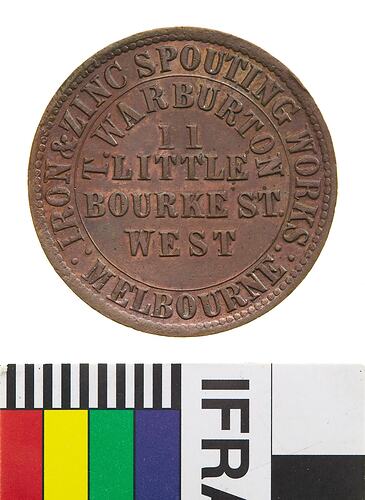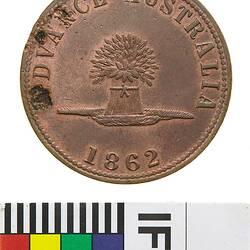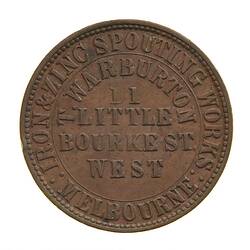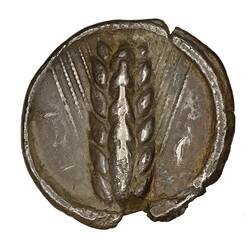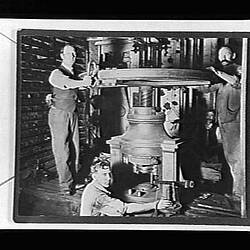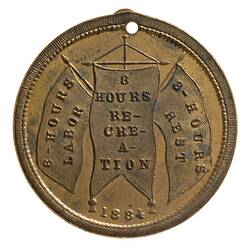Summary
Australia Victoria Melbourne
T. Warburton Token Penny, 1862 (AD)
Mint: Thomas Stokes
Previous Collections: George McArthur
Standard References: Andrews 600 = Heyde 263/2 = Sharples 176
Other Details: Die combination B / Sheaf 1 see notes tab for details. Token has been cleaned and has deep pitting on reverse.
Physical Description
A copper trade token penny (32 mm diameter) featuring the name address and business of the issuer: T. Warburton, 11 Little Bourke St. West, Melbourne, Iron & Zinc Spouting Works. The reverse is from a Stokes stock die Sheaf 1: At centre a wheat sheaf tied with a cord, above, ADVANCE AUSTRALIA; below, 1862.
Obverse Description
At centre within a line circle T. WARBURTON 11 LITTLE COLLINS ST. WEST around, IRON & ZINC SPOUTING WORKS : MELBOURNE :
Reverse Description
At centre a wheat sheaf tied with a cord 4.7 mm long, above, ADVANCE AUSTRALIA; below, 1862 border of 114 beads. (Stock reverse Andrews type 21 = Heyde Sheaf 1 = Sharples Sheaf 1)
Edge Description
Plain
More Information
-
Collection Names
-
Collecting Areas
Home & Community, Numismatics & Philately, Working Life & Trades
-
Acquisition Information
Transfer from National Gallery of Victoria (NGV), George McArthur, 15 Mar 1976
-
Date Issued
1862 AD
-
Issued By
Thomas Warburton - Iron & Zinc Spouting Works, Melbourne, Greater Melbourne, Victoria, Australia, 1862
-
Mint
-
Previous Collection
-
Inscriptions
Obverse: T. WARBURTON 11 LITTLE COLLINS ST. WEST MELBOURNE IRON & ZINC SPOUTING WORKS Reverse: ADVANCE AUSTRALIA 1862
-
Denomination
-
Series
-
Material
Copper
-
Axis
06
-
Classification
-
Category
-
Discipline
-
Type of item
-
Dimensions
34 mm (Outside Diameter), 11.992 g (Weight)
-
Shape
Round
-
References
Andrews 600 = Heyde 263/2 = Sharples 176 T. Warburton advertised in the Melbourne Directory for 1862 as a galvanised iron spout maker. The same year he employed Stokes to strike a large order of penny tokens. Three obverse dies were needed to complete the order using Stokes stock reverse dies for the reverses. In all seven combinations of dies have been confirmed with an additional two reported by Andrews and repeated by Heyde (with the rider Not Seen) rejected by Sharples (JNAA.7.67-8). Identification of the obverse die employed for a particular token can be made by following the steps: 1. If there is no stop after the abbreviation ST of BOURKE ST it is obverse C 2 If there is a stop and the word WEST is 11.0 mm long it is obverse B 3. If there is a stop and the word WEST is 11.8 mm long it is die A (this die cracked down the left side through the letters NC od ZINC through the W, T and B to the I of IRON if present this die crack is a clear identifier of obverse A.) The museum storage and standard references are based on these die identifications. The following die combinations with stock Stokes reverses (Numbered according to Sharples JNAA.7 pp. 5 -10) have been confirmed: A/Emu 1 (two weight standards), B/Sheaf 1, B/Arms 6, C/ Emu 1, C/Vine 1, C/Vine 2 and C/Sheaf 1
[Book] Andrews, Arthur. 1921. Australasian Tokens and Coins.
[Book] Heyde, Gilbert C. & Skinner, Dion H. 1967. Unofficial Coins of Colonial Australia and New Zealand.
[Article] Sharples, John P. 1993. A Catalogue of the Trade Tokens of Victoria 1848 to 1862. Journal of the Numismatic Association of Australia. vol.7: p.1-77.
-
Keywords
Housing, Iron & Zinc Spouting, Plumbing, Urban Development, Wheat
